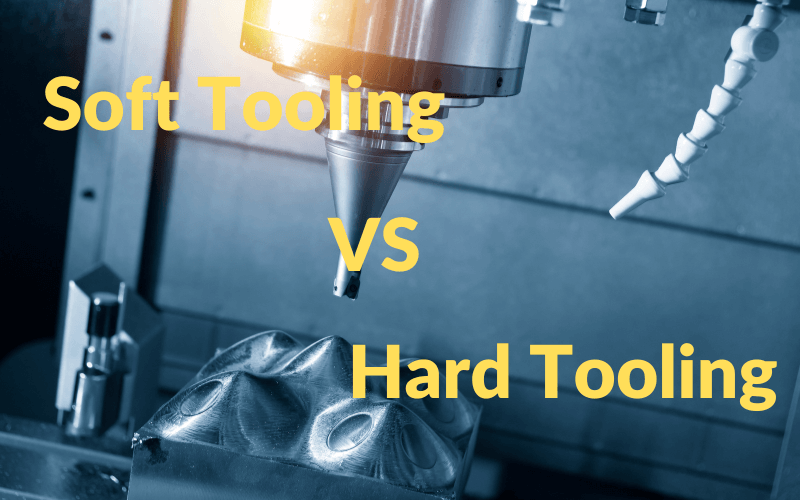When it comes to CNC machining, most manufacturers already know it well. But you must be full of questions about the molds required for CNC machining. CNC machining tools can generally be divided into two broad categories: Soft tooling and Hard tooling. In order to better turn designs into reality and convert raw materials into finished products, molds play a vital role. This also shows us one thing: choosing the right mold is a very important thing!

So in the actual process, should we choose soft tooling or hard tooling? If you are confused about this, this article is for you. Here, we show you in an all-round way what soft tooling is, what hard tooling is, and what are the differences between them. Without further ado, let’s get started!
The meaning of soft tooling and hard tooling
Next, we will explain to you what is soft and hard tooling.
Soft Tooling
Soft Tooling is an economical and efficient molding method. It is often used to make polyurethane moldings, helping manufacturers produce low- to medium-volume parts. For those prototyping or other projects that require simple functionality and smooth surfaces, soft tooling is usually a good choice. Of course, for creating more complex mold patterns, soft tooling takes less time than other methods.
Soft tooling has many advantages, among which flexibility in material requirements is one of the important reasons why many manufacturers choose it. Because there is no need to worry too much about compatibility. However, it lacks durability and wear resistance compared to hard tooling because the material it is made of is soft.
The most common material used to make soft tooling is silicone.
Hard Tooling
Hard tooling is the most commonly used processing method in injection molding. It is durable and wear-resistant, so it can withstand multiple production cycles. Typically used for the production of high-volume parts. But what you need to know is that if there are strict requirements for tolerances, then hard tooling has advantages over soft tooling.
Compared to soft tooling, using hard tooling is more time-consuming. This is because hard tooling requires heat treatment, post-processing, and additional machining to achieve a smooth surface. The smooth surface ensures seamless lamination, which is very important for hard tooling.
The difference between soft and hard tooling
To choose the right mold to understand their general applications, you also need to learn the differences between them. Next, we will show you the differences between them in the form of the table:
| Project | Soft Tooling | Hard Tooling |
| Materials | Silicone, Carbon fiber composites, Fiberglass | Steel alloys, Nickel alloys, Aluminum alloys |
| Cost | Low. This is because the materials used in soft molds, such as silicone, carbon fiber composites, or fiberglass, are generally less expensive than the durable metals used in hard molds | In the short term, the cost is higher; but in the long term, it still has the advantage of saving costs. |
| Dimensional Accuracy | Over time, soft tooling materials may deform or wear, resulting in lower dimensional accuracy. | Over time, soft tooling materials may deform or wear, resulting in lower dimensional accuracy. |
| Period | Long | Short |
| Material Compatibility | There are some limitations. Not suitable for high-temperature or abrasive materials with robustness and heat resistance. | Compatible with a variety of materials including engineered plastics, metals, and composites. |
| Surface Finish Control | Provides a smoother surface, but finish control is not as good as hard tooling. There may be limitations in achieving certain surface finishes, textures, or details. | Provides less smoothness than soft tooling. But gives better control over the surface finish. Surface texture or finish can be precisely designed and replicated in rigid molds. |
| Repeatability | The manufacturing material is soft, not very durable wear-resistant, and has low repeatability. | Very durable and can withstand high pressure and high-temperature conditions for long periods of time. High repeatability. |
| Production Capacity | Suitable for medium and low-volume parts production | Suitable for mass production of parts. |
| Heat Resistance | Low | High |
Extra Tips: Soft machining vs. hard machining
Here, we will also introduce you to soft machining and hard machining.
Soft Machining includes CNC turning, CNC milling, Gear hobbing, Deburring, Broaching, Generation skiving, and other CNC machining processes.
Hard Machining is typically a final manufacturing operation performed on parts and assemblies, and the required dimensions and surfaces are affected by the hard machining parameters and conditions.
Conclusion
So far, you have understood what is soft and hard tooling, and what is the difference between them. But it is well known that a partner who relies on friends is also the core influencing factor in turning design into reality. Here, CNCMass is your best choice. Because it can turn your design into reality in a professional and advanced way according to your needs.



